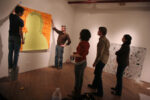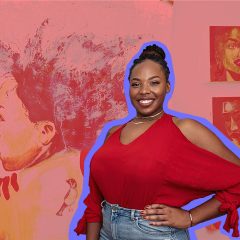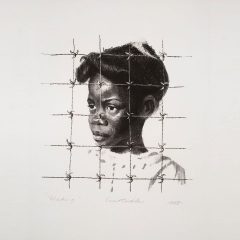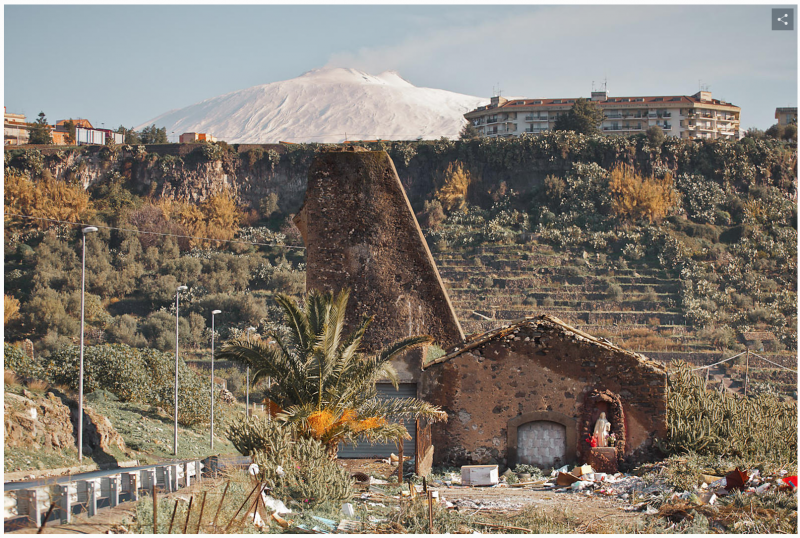
Marianne Bernstein‘s most recent curatorial project, like all her works, is complicated. Due South involves many people, lots of moving parts and a strong curatorial desire for cross-cultural understanding. Part of the project took place in Sicily and involved an artist residency for invited Philadelphia artists to make works based on their research and findings on the island. The other part of the project is an exhibition (and ancillary programming) with Sicilian artists and the Philadelphia artists. (Due South is a sister exhibit to Due North, which took place in Iceland –with an exhibit in Philadelphia — in 2014)
I saw Due South at The Delaware Contemporary in late April (the show ran from Jan. 28-April 30, 2017), and the exhibition by the 36 Sicilian and Philadelphia artists cast a spell that still lingers, partly due to a few of the gorgeous works in the show, but also because of the ideas the show brought together. I hadn’t expected Due South to be political, but it was. Many of the works dealt with today’s front page issues – power, money, and the current refugee crisis. And the works that were more personal explored themes of national identity and touched something raw and vulnerable about humans and our clinging to an “us” versus “them” mindset. It was a marvelous show and reverberated with much of my thinking about how art can bring issues to light and not hit you over the head or preach but be successful in steering thoughts into territory where our common humanity wins out over innate prejudice and fear. Below is Part 1 of my interview with Marianne Bernstein.
Roberta – The show has many beautiful works, haunting beauty in fact…Do you see it as mournful? And I don’t just mean the refugee crisis which some works deal with, which is a huge tragedy. But overall the ambiance is like a gorgeous dirge, like that Samuel Barber Adagio – sad, sweet, haunted.
Marianne – I love that Samuel Barber adagio, it’s so richly full of sadness and passion, both empowering and destabilizing, just like life. He feels like a kindred spirit. My own soul feels similarly dark and brooding, which in turn directs reflects my choices as an artist and curator. My choice to explore Sicily (and volcanic islands in general) is not accidental. I’m inspired by people and places that are marginal or isolated as well as by human struggle and resilience. My palette as an artist tends to lean towards darkness as well, but the darkness is not empty, it’s endless and velvety, like nighttime or outer space.
R – The walk through the show is like walking from a lightened space into a space that figuratively becomes ever more slippery and then literally becomes darker and darker. I really like the layout.
Marianne – As with Due North, much of the work was created over the course of a few years specifically for the exhibition, which is always a big risk. Because we worked so closely with each other together however, I had faith that the final works would speak to each other, but the danger was appearing too fragmented, like a big group show. We were fortunate to have three huge galleries but I had to pair down the works in the show considerably.
I always try to create an “experience” with an intention to transform the viewer in some way through sensual experience. Due to the sheer numbers of artists (36) in the show, I arranged each room thematically, and your observation is correct, there was a progression of light to dark. The first gallery became an overview, an introduction: a colorful, saturated portal meant to both invite and deceive. Though the overall sense was welcoming, playful, bright, and colorful -upon closer inspection most of the works were already setting up the dialectic of the show:—the idea of “south” as a place of warmth and hospitality, but also backwardness and poverty, a study in contrasts: the intense geology of the island, rich vs.poor, love and hate, the south as a mirror to the best and worst in human behavior.
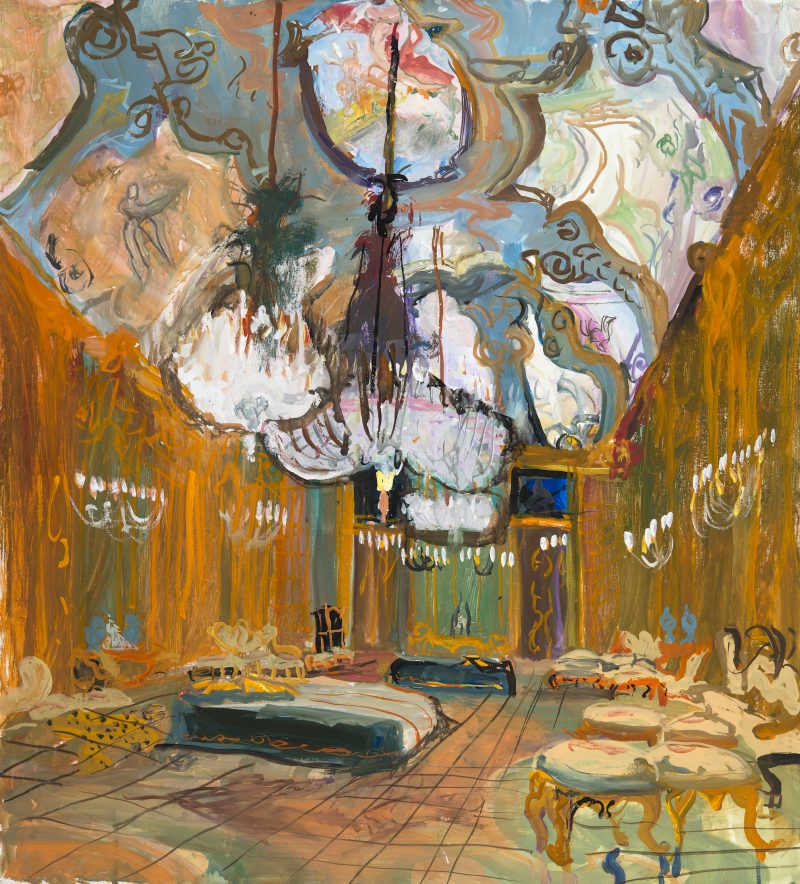
Jane Irish’s paintings of palazzos, function as both eye candy and a testament to the pillaging of cultures to obtain those stolen works of art ; Francesco Nonino’s plants were photographed in a site of radioactivity from a crashed US plane near the Sigonella air base, Massimo Cristaldi’s sumptuous photographs show abandoned unfinished buildings and structures so common in Sicily, the product of dreams vs. reality.
The middle space darkens slightly, becomes a City scape, with its raucous street sounds and sensations, but it remains rich in metaphor. As with the entire show, the effect is meant to be poetic and visceral, allowing for a free conversation between works: the richly diverse, yet tragic history of conquering cultures, ghosts of the Mafia,. Flavio Favelli’s cardboard cube- “Damnatio Memoriae, “condemnation of memory”, with its consumer labels sanded off, and braille like surface, offers up cancellation and historical amnesia as both a blessing and a curse. It grounds the room—a foreign, oddly humorous, almost religious space (resembling the Kaba in Mecca), with no entry, and impossible to decipher.
As an antidote to Sicilian stereotyping, there is only one obvious and essential nod to the Mafia, the photograph by Letitia Battaglia of a woman weeping moments after her husband was murdered. Another work in the middle room references the Mafia and its entrenchment in everyday society, in a much more subtle way—a painting by Favelli of a large bank note check written out by a jailed Mafiaso, which functions as a totem to the mingling of gods and commerce, to be deciphered upon close inspection.
These choices are intentional, because of my desire for the viewers, like the Due South artists, to move beyond stereotypes of Sicily, to jump into the rabbit hole as travelers; to explore, and experience the island through fresh eyes.
Sitting in a darkened room David Kessler’s video transports you to the Medieval town of Tusa, where many of us lived for weeks, (thanks to Serena Perrone who has returned each summer to join her father who was born there). Many of the participating artists joined us in Tusa, some are in the film, including locals we befriended. We wanted the audience to virtually return with us, not as tourists but as travelers, and have their own experience.
The final room, while specifically referencing the refugee crisis, has a larger intention. In the darkness, the space is meant to be further explored as a meditative space; a chance to look within, an elegy to life and death, to crossing borders in our own lives, hope vs. despair. And once again, the viewer is encouraged to consider conflicting perspectives, including the question of subjectivity and who gets to write history? Lulled into the meditative sound of waves crashing against a beach, a bright pink child’s raft drifts back and forth. Soon, there is the grim discovery that this beach was recently a graveyard of African refugees recently drowned in sight of land when their flimsy rescue boat overturned. I didn’t want to overdo the idea of refugees but it was a theme I was grappling with at the time in my own personal work and deliberately brought the artists to this beach and to the boat “graveyard” nearby (depicted in Isaac Julien’s large Duratran lightbox). The refugee crisis symbolizes many pressing local and global issues: the demonization of the foreigner in times of fear and insecurity, our role as victims and victimizers, and artists as essential agents of change.
Volcanic islands breed a certain glorious independence, yet often are a study in extreme contrasts, demonstrated both in the land and its people, inextricably intertwined. Volcanoes, like people are taken to periodic fits. One moment can be paradise, the next, a living hell. Island inhabitants are moody, and can switch from one extreme to another without warning. Which made our role as foreigners so interesting, because our own personal lives were played out in front of us like a Verdi opera. It helps us recognize both the lightness and darkness each of us hold within us.
R – Why Iceland and why Sicily?
Marianne – I first travelled to Iceland in 2011, in the middle of winter. It was a magical, transformative trip, there was four hours of daylight and the frozen water around me was milky blue. I felt the curious magnetism of a volcanic island, the extremes of fire and ice, people both playful and serious; and a wind that swept me off my feet. The longer we spent time there, the more our own preconceived notions of what “North” meant fell away. We did not travel comfortably as tourists, our intent was to live simply among townspeople and try to open up as much as possible to the full spectrum of daily life. This included the encounters with the sublime (Northern lights), the terrifying (the North wind and blizzards), and the banal (a rising consumerism and fast junk food culture), and everything in between (real life). Along the way, we met Iceland’s best artists person to person, including the legendary Ragnar Kjartansson, before he hit the world stage. I am very proud that his work and others were featured in Due North.
I love the idea of travel as “a journey”, and its similarity to the creative process in general. Exploring without knowing the result and being open expands our sense of possibility. We can lose ourselves in travel and create new relationships. It is thrilling to do this as a group, to learn from and be inspired by one another, especially in an international context at this moment in time, when communication in general is in breakdown. I was also interested in the exploring abstract notions of place beginning with the idea of north.
Volatile geology has a tendency to breed isolationism, a sense of pride and anger, but also a glorious independence and passion. Stereotypically, both Iceland and Sicily have been viewed as confounding cultures of contradictions. In the North, this has been manifested in a stoic reverence for nature and the supernatural, as well as a cool distrust of foreigners; in the south, in opposing states of mind: self loathing and egotism along with a fear of change. But stereotypes are shaped from a distance. As we navigated unknown territory however, our challenge was to reshape fixed notions– experiencing both ourselves and this exotic island anew.
Due South became a natural progression from Due North. Serena Perrone kept musing during our Due North travels that Iceland reminded her of Sicily. This delighted and surprised me, sparking a curiosity in pursuing other volcanic islands. Sicily became the next natural choice, this time exploring new personal and geographical terrain as well as abstract notions of south over the course of three years. My method of curating is unusual and somewhat risky. Finding artists, like the creation of each exhibition, is a very organic process, much like making a homemade soup, adding a little bit of this and that until it’s done. I try to keep an open mind and have no idea what the exhibition and work will look like until the end. It’s the way I work best, improvised, diving into unexplored terrain, bringing people together, and seeing what happens. It’s thrilling to do this as a group, and involves a lot of trust.
R – Is the work all newly created? Who do you see as the audience for the shows?
Marianne – Each artist had the liberty of creating their own work, with very little parameters. Us foreigners needed to immerse ourselves in the culture and then create whatever work naturally evolved. The locals were asked to present or create new work for the exhibition that reflected their relationship to their island. Much of the work created for Due North was abstract, but the 120’ video wall immediately transported the visitor to Iceland with films created by David Kessler and Rebecca Mendez. Being surrounded by the Northern Lights and the vast Icelandic landscape in that huge space was magical. For Due South, perhaps the works themselves were more informative. Cindi Ettinger became fascinated by the history of conquering cultures as well as the decor of many Sicilian homes which reminded her of South Philly interiors. So she blended history and kitsch. Each work evolved according to each artist’s interests and experiences. In Due South, we were all over the island, the southern end has a primarily Greek influence, the other closer side to Palermo, an Arabic feel, so you got an interesting mix places and flavors.
As for the audience, I think there is something for everyone.
R – What’s next?
Marianne – I am hoping to complete a quartet of volcanic island explorations–Due East and Due West.
But I will need to find funding first. I also want to curate an exhibition featuring contemporary Native American voices, inspired by my visit to Standing Rock during Thanksgiving, as well as continuing projects in the public sphere.
Part 2 of this interview with Marianne Bernstein will run next week. Stay tuned!



